Headlines
Oxford Stories: J. D. Williams Library Changes With The Times
The J.D. Williams Library has been serving students and the University of Mississippi and Oxford community since 1951.
The library has traditionally stood as a resource for students to research and study, but as the university moves into the information age, the library is rapidly changing as well.
New pushes for increased research and data capabilities, innovative design platforms, increased study space, and interactive areas characterize the modernization of the J.D. Williams Library.
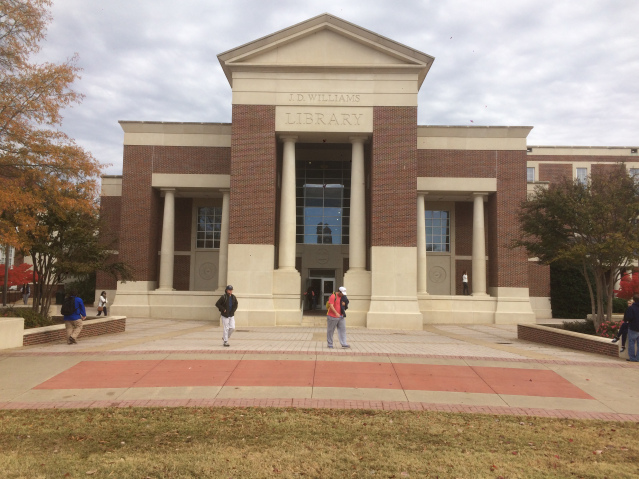
The J.D. Williams Library is a vital asset to students and faculty alike at the University of Mississippi. Photo by Jack Hall.
Standing proudly across from the Lyceum, the J.D. Williams library is at a central location, an important factor in attracting students to its halls. The library offers over 1.7 million books, over 40,000 periodicals, over 460 electronic databases, over 90,000 electronic journals and nearly 305,000 electronic books. The archives includes 46,000 texts and 700 manuscript collections pertaining to Mississippi history, blues music, politics, and the American South.
Dean Cecelia Botero, a University of Miami and University of Texas at Austin educated professor with more than 30 years in the library field, was named dean of libraries at the University of Mississippi in July 2016. She envisions a library able to meet the student and faculty demands in the future.
“I was brought here to bring some change to the library, and that’s what we’re working on,” Botero said. “We’d like to create more public space. We’d like to move more into the digital era, have more digital collections, more interactive learning spaces. We’d like to provide a larger variety of activities that can happen in the library.”
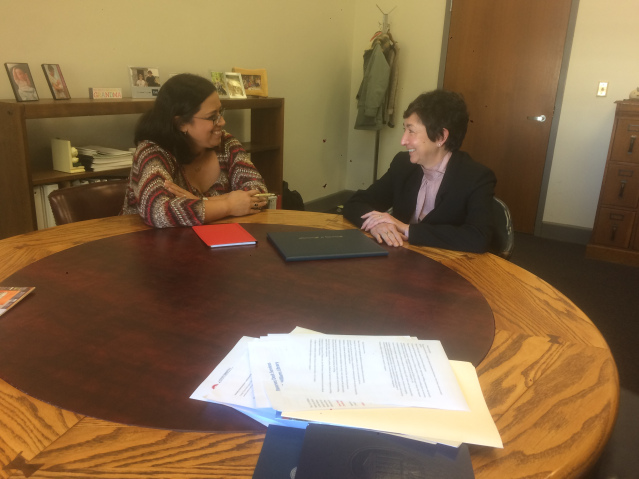
From left, Assistant Dean Tipton and Dean Botero discuss matters privy to the future of the J.D. Williams Library. Photo by Jack Hall.
She sees the primary purpose of the library to be of service to students. “The library is kind of home for students while they’re on campus, and that’s what we’re striving to do,” Botero said.
However, there is always room for advancement in research capabilities. “We have a lot to offer, not just for studying and helping students, but also we have a lot to offer for professional students as they move forward, as we move more into research,” Botero said. “We can meet those needs. Libraries have a lot to offer in all those areas.”
Jocelyn Tipton, assistant dean for public services, noted the introduction of internal renovations to bring the library into the 21st century. Although the actual building has been renovated most recently in the 1990s, the current focus has been adding state-of-the-art facilities within the existing structure.
“The other renovations we’ve had have really just been rethinking spaces within the building,” Tipton said. Last year, they created Studio One, a one-button video studio, and reconfigured the space.
“Studio One is on the first floor off our information commons,” Tipton said. “It’s modeled after a one-button studio at Penn State. The idea is that students who are working on multimedia or multi-model projects need a place where they can do that work. Whether it’s filming, video editing, practicing for presentations, conducting online interviews, all those types of activities can be done within the studio.”
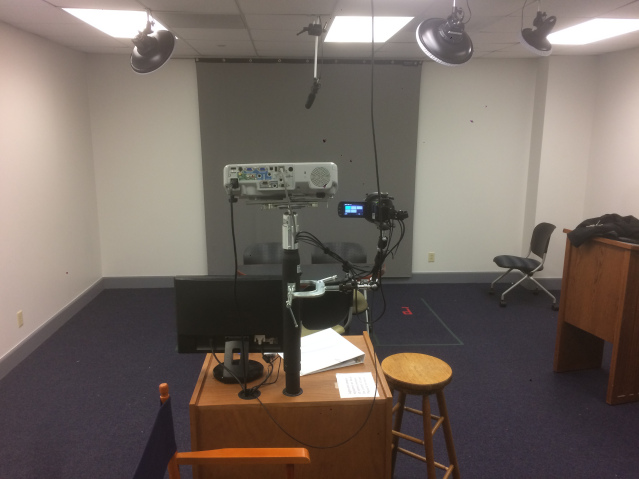
The state-of-the-art Studio One is available to students and faculty during normal hours of operation for the library. Photo by Jack Hall.
Studio One can be accessed by students and faculty alike for a multitude of projects.
“If a music student needs to use it for an audition tape, they can use it for that,” Tipton said. “If someone just wants to see what they look like in front of a class, they can use it to record themselves that way. It’s simple to use.
“The idea is that it’s set up ready to use. You just come in, put your flash drive in, push a button, all the lights come on, the camera activates, so you don’t have to know how to do any of those things.”
In addition to Studio One, more than 150 workstations featuring desktop computers, and multiple study areas, the J.D. Williams Library is blessed with notable special collections within the archives department.
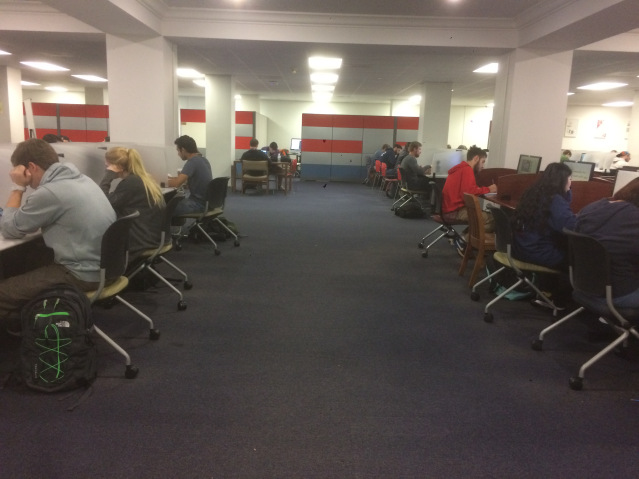
Students study in the information commons on the first floor of the library. Photo by Jack Hall.
“We’ve got some excellent special collections, which we are proud of, including the blues collection, a Mississippi history collection, as well as a second folio of Shakespeare’s works,” Botero said. “We’re also a federal documents depository library.”
The second folio was purchased from an auction house with the help of the Ford Foundation on campus. This particular copy was owned by Edwin Booth, a 19th century stage actor and brother of John Wilkes Booth, the assassin of President Abraham Lincoln. Edwin Booth was best known for his portrayal of Shakespeare’s Hamlet.
But that’s not all.
“We’re also the AICPA [American Institute of Certified Public Accountants] library, so for the accounting professionals throughout the country, we serve as their primary point of resources in historical accounting information,” Tipton said.
Dr. Jennifer Ford, who graduated with a bachelor’s degree in history from Millsaps College, a master’s degree in history and an M.L.S. from USM, and a doctorate in history from the University of Mississippi, has worked in many capacities within the library for 17 years. In 2005, she was named the head of the Department of Special Collections and Archives.
“The archive was not formally established as the Department of Special Collections and Archives until 1975,” Ford said. “It existed before that as the Mississippi Room and, in fact, you’ll still hear people from the community refer to us as the Mississippi Room. For several years, Dorothy Oldham, William Faulkner’s sister-in-law, ran the Mississippi Collection.”

Dr. Ford examines a map of territorial Mississippi in the archives. Photo by Jack Hall.
With Ford’s extensive experience at the University of Mississippi, she has seen department growth within the library.
“[The archives has] grown tremendously through the years,” Ford said. “We’ve acquired different archives across the campus. Within the last 15 years, we’ve doubled our holdings.
“The former director made a concerted effort to collect Faulkner as much as possible. First editions we did not already have in a dust jacket, the Rowan Oak papers, 1800 pages of early Faulkner manuscripts, were acquired in the late 1970s or early 1980s. We also received a substantial Faulkner poetry collection.”
Dr. Ford came to the archives when it was primarily a resource utilized by graduate students and private researchers, but Ford has been working to extend its accessibility to undergraduate students as well.
“We were historically used fairly heavily by graduate students and people from outside the university who knew of our collections, coming from all around the world,” Ford said. “We’ve been trying to reach out more recently to undergraduate students, because many of them don’t know how to conduct research in an archive or how to use primary documents when they arrive on campus. We try to show them what our resources are, help them conduct research for papers, and show them how to use primary documents, because it’s different from the rest of the library.”
Dr. Ford, in step with Dean Botero and Assistant Dean Tipton, sees the future of the archives as being online, just as archives and libraries across this nation are moving towards.
“We would like to develop the university archives even more than it already is,” Ford said. “I’d like our digital program to continue to expand because that is a direction that archival research is being done increasingly in this time.”

The Department of Archives and Special Collections is located on the second floor of the J.D. Williams Library. Photo by Jack Hall.
Ford has a vast knowledge of the history behind the libraries that have existed on campus.
“The first library was actually in the Lyceum, and the first librarian served in a dual capacity as a housekeeper as well,” Ford said. “This university has placed a great deal of emphasis on the library. It has existed in several buildings after the Lyceum, including Ventress Hall and Bryant Hall, before its eventual move to the J.D. Williams Library, which opened in 1951.
“It initially had closed stacks so, at first, students had to request material,” Ford said. “So if students think it’s hard to use the library now, it was really labor intensive at the time.”
It wasn’t all that archaic though; the library was the first building on campus to feature air conditioning. Ford also explained the ornate printer’s marks seen around the library.
“They refer to different printers who used those marks to distinguish their publications, and we have a guide to the marks seen throughout the library,” Ford said. “The director of the library at the time had them installed, and he had a very deep interest in the history of the book, and I think he felt that those were very appropriate to incorporate into the library’s design.”
Finally, Ford offers the community the opportunity to attend archive events throughout 2017.
“Next year is Mississippi’s bicentennial, and we will be hosting an exhibit in the Faulkner room,” Ford said. “I would like to invite folks. It’ll start Jan. 9 and will run throughout the entire year. We’re hosting a series of lectures and presentations.”
There are also student-employee and student perspectives on how the library operates to their use.
Tesha Cistrunk, a senior elementary education major from Louisville, Mississippi, started working in the library at the start of this semester.
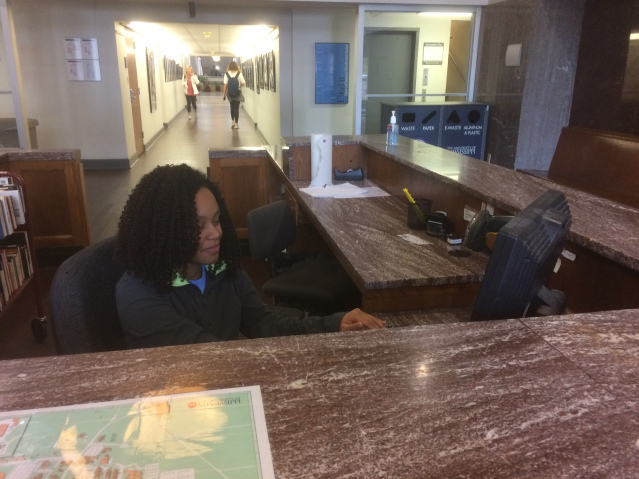
Tesha Cistrunk types away during her shift as a desk assistant at the J.D. Williams Library. Photo by Jack Hall.
“My favorite part is getting to interact with all the people who come in the library, getting to talk about their books and professors,” Cistrunk said. “I used to like going to my library in my hometown and doing work there even in middle school and high school. I think it’s a good resource for those who use it. Not everyone does.”
Cistrunk also noted how and when students use the library.
“It’s really busy from noon until 1 p.m., with the exception of Friday,” Cistrunk said. “I think the times of the library are really good, especially during finals when there are extended hours.”
Brennan Trask, a senior marketing major from Jackson, Mississippi, routinely studies in the library.
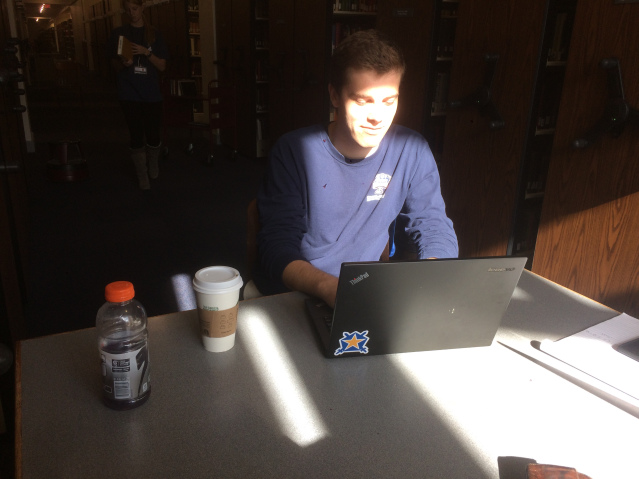
Brennan Trask studies for his upcoming final exams on the second floor of the J.D. Williams Library. Photo by Jack Hall.
“The library is just a convenient spot on campus,” Trask said. “It’s got the most study space. I’ll sometimes use the [second floor] mezzanine. I’ll also study in buildings where I have classes, like Conner Hall or Holmann Hall.”
“I sometimes use the computers [on the second floor],” Trask said. “I usually study by myself, but sometimes I’ll study downstairs at one of the larger tables with a study group. I’ll come after my morning classes and throughout the day. I’m usually in here more towards the end of the semester. The 24/7 schedule for finals week is very helpful.”

Students study alone and in groups in the J.D. Williams Library. Photo by Jack Hall.
Trask brandishes a cup of coffee on the table beside his laptop.
“Usually I grab a cup of Starbucks before studying,” Trask said.
The J.D. Williams Library stands poised as an invaluable resource to the students and community around it as long as it remains. Dean Botero leaves the community with an opportunity to reach out and let their needs be heard.
“Every idea is welcome and they’re not unheard,” Botero said. “We’re welcome to input.”
By Jack Hall. Read more stories like this on Oxford Stories.
For questions or comments, email hottytoddynews@gmail.com.





























